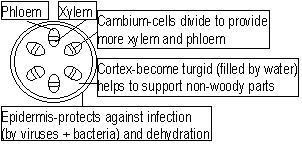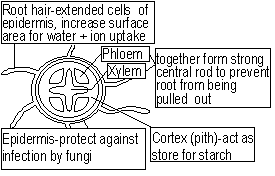Bio4
TRANSPORT IN PLANTS
Translocation-transport of materials in plants-takes place in groups, vascular bundles, which extends through whole plant and consists of xylem and phloem-stopped by inhibitors of cell metabolism
Xylem-for mechanical support & to conduct water w/ dissolved mineral salts from roots to stem and leaves
Phloem-transports manufactured/organic food from photosynthesis [glucose in form of sucrose(sparingly soluble in H2O) and amino acids] Consist of sieve tubes and companion cells. Food can go up and at the same time
Vascular bundle also provides support, contain vessels, fibres, other thick-walled, lignified, elongated cells
Usually arranged in a cylinder, this distribution helps resist sideways bending forces
Roots-absorb water and mineral salts via root hairs
Root hairs-minute, finger-like projections from root epidermis


Absorption of water
Absorbed by root hair cells by osmosis [conc. cell sap (glucose and salts)] Root hair cell >(osmosis)> root hair cell Sometimes by active transport
Absorption of mineral salts
Absorbed mainly by active transport (conc. cell sap) (energy utilised) [diffusion + osmosis(in water) possible]
Water movement across cortex to xylem
Water enters root hair cell > turgor pressure increase > forces some water into cell wall > water potential increase
Water travels 1in or between cell wall-cell wall, 2vacuole-vacuole, 3cell-cell,osmosis. Continues until xylem
Water movement up xylem
Transpiration pull- suction force due to evaporation of H2O from leaves (main force)
Root pressure-pressure caused by incoming H2O molecules, helps H2O to go up xylem
Capillary effect-accounted by adhesion and cohesion
adhesion-H2O molecules 'cling' to inner surface of xylem vessels
cohesion-H2O molecules stick to one another (attraction of opp. dipoles)

To test functions of plant tissue
Phloem; cover leaf w/ 14CO2 (radioactive),aphids (greenfly) sample contents-radioactive sugars (sstransport sugar)
Xylem; place plant in water-soluble dyes, trace pathway of water movement
Roots; place inhibitors of respiration, active uptake of ions stops
TRANSPIRATION
Transpiration
-(loss of water from plant) or
When water (absorbed by roots > brought to all parts of plant by xylem vessels) lost by evaporation from surface of mesophyll cells/by diffusion through stomata
Stomatal transpiration-water loss from aerial parts of plant esp. through stomata
Cuticular transpiration-water loss by direct evaporation from surfaces of epidermal cells when passing through cuticle
Evaporation of H2O from leaves causes a suction force which pull water up xylem vessel-transpiration pull-main force which H2O and mineral salts are brought up on the plant. Transpiration stream-the streaming of water up plant
Importance
-transpiration stream + pull (caused by transpiration) enable water + mineral salts to by distributed through the plant
-water streaming up the plant causes plant to be turgid, for shape + support
-the evaporation of H2O cools plant by taking latent heat away. Prevents plants from getting scorched
Potometer-used to measure transpiration rate [actually, H2O intake (H2O lost during transpiration)]
Factors
External
Humidity-amount of H2O vapour in air. air saturated w/ H2O>can't hold much H2O>conc. Gradient low + diffusion low + transpiration low (too much H2O vapour in air transpiration might stop, H2O lost by guttation, liquid H2O lost through hydathodes in leaf)
Temperature-higher temp. easier H2O evaporates, air can hold more H2O vapour
Light intensity-can bring heat. It controls opening and closing of stomata, by guard cells, due to conversion of ions (photosynthesis) (affected by light), guard cells increase in glucose conc., water enters, osmosis, increase in turgidity, stomatal pore bigger
Wind-water evaporates from plant and a 'shell' of H2O vapour surrounds plant, saturated which H2O, high humidity, low conc. gradient, low transpiration. air movement removes 'shell'
Availability soil H2O-H2O absorbed from soil. more H2O in soil, more water intake, more transpiration
Internal
Leaf surface area + surface area to volume ratio-larger surface area, more stomata + more sunlight (heat) absorbed, more transpiration. high surface area to volume ratio, high transpiration
Cuticle-waxy, shiny substance on leaf surface, reflects light. Thicker less heat absorbed, lower evaporation
Density of stomata-more stomata, more space for H2O loss, more H2O loss by diffusion, high transpiration
Wilting-more H2O lost than taken in (water stress), turgor pressure decreases, cells flaccid, plant droops (wilts) temporary wilting-too much H2O loss, transpiration slowedpermanent wilting-dead
Stomata opening and closing depends on light intensity, CO2 conc., humidity
Support, Movement and Locomotion
Transport system in man-circulatory system
Respiration
Excretion
Homeostasis
The Eye
Nervous System
Chemical Control of Plant Growth
The Use and Abuse of Drugs
Diversity of Organisms
Nutrient cycles and Ecology
Parasitism
The Human Impact on the Environment
Reproduction in plants
Sexual reproduction in animals
Genetics
Cell Structure and Organisation
Enzymes
Nutrition
Back to 'O' level notes index
Back to notes index


